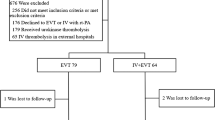Abstract
The aim of early thrombolytic therapy in acute stroke is to obtain early recanalization of occluded cerebral arteries and prevent or reduce irreversible ischemic brain damage. In this study, Seldinger technique and digital subtraction angiography were used to verify thromboembolic occlusion of the common carotid artery by an autologous 12-hour-old thrombus in 28 rabbits. Thirty minutes after embolization, 2 mg/kg of recombinant tissue-plasminogen activator (rt-PA) was delivered intravenously by way of the femoral vein in group A (n = 8) and through a local intraarterial infusion in group B (n = 8). Twelve control animals received an equivalent volume of saline intravenously (group C, n = 6) or by local intra-arterial infusion (group D, n = 6). A comparison of posttreatment angiographs of the treatment groups and the control groups was used to demonstrate reperfusion induced by thrombolytic therapy. None of the control animals showed any evidence of recanalization. Both intravenously (group A) and intra-arterially (group B) treated animals achieved 100% recanalization, although the average time to recanalization was significantly longer in group A (P = .01; 123.7 vs 82.5 min). These results suggest that local intra-arterial administration of rt-PA within 30 minutes produces more rapid reperfusion compared with the intravenous route. Further studies and additional treatments are needed to widen the therapeutic window and decrease hemorrhagic side effects.
Similar content being viewed by others
References
Yepes M, Sandkvist M, Wong MK, et al. Neuroserpin reduces cerebral infarct volume and protects neurons from ischemia-induced apoptosis.Blood. 2000;96:569–576.
Fisher M, Bogousslavsky J. Further evolution toward effective therapy for acute ischemic stroke.JAMA. 1998;279:1298–1303.
Toomey JR, Valocik RE, Koster PF, et al. Inhibition of factor IX (a) is protective in a rat model of thromboembolic stroke.Stroke. 2002;33:578–585.
Adams RD, Victor M. Cerebrovascular diseases. In:Principles of Neurology. New York: McGraw-Hill; 1993:669–748.
The National Institute of Neurological Disorders and Stroke rt-PA Study Group. Tissue plasminogen activator for acute ischemic stroke.N Engl J Med. 1995;333:1581–1587.
Hacke W, Kaste M, Fieschi C, et al. Intravenous thrombolysis with recombinant tissue plasminogen activator for acute hemispheric stroke: the European Cooperative Acute Stroke Study (ECASS).JAMA. 1995;274:1017–1025.
Haefelin CN, Brinker G, Pillekamp UU, Hossmann KA, Hoehn M. Prediction of hemorrhagic transformation after thrombolytic therapy of clot embolism.Stroke. 2002;33:1392–1398.
Hacke W, Kaste M, Fieschi C, et al. Intravenous thrombolysis with recombinant tissue plasminogen activator for acute stroke.JAMA. 1995;274:1017–1025.
Clark WM, Wissman S, Albers GW, et al. Recombinant tissue-type plasminogen activator (alteplase) for ischemic stroke 3 to 5 hours after symptom onset.JAMA. 1999;282:2019–2026.
Clark WM, Albers GW, Madden KP, Hamilton S, for the Thrombolytic Therapy in Acute Ischemic Stroke Investigators. The rt-PA (alteplase) 0–6-hour acute stroke trial, part A (A0276g). Results of a double blind, placebo-controlled, multicenter study.Stroke. 2000;31:811–816.
Philips DA, Davis MA, Fisher M. Selective embolization and clot dissolution with tPA in the internal carotid artery circulation of the rabbit.AJNR. 1988;9:899–902.
Hamilton MG, Lee JS, Cummings PJ, Zabramski JM. A comparison of intra-arterial and intravenous tissue type plasminogen activator on autologous emboli in the cerebral circulation of rabbits.Stroke. 1994;25:651–655.
Russell D, Madden KP, Clark WM, Zivin JA. Tissue plasminogen activator cerebrovascular thrombolysis in rabbits is dependent on the rate and route of administration.Stroke. 1992;23: 388–393.
Zeumer H, Freitag HJ, Knospe V. Intravascular thrombolysis in central nervous system cerebrovascular disease.Neuroimag Clin North Am. 1992;2:359–369.
Morgenstern LB, Staub L, Chan W, et al. Improving delivery of acute stroke therapy. The TLL Temple Foundation Stroke Project.Stroke. 2002;33:160–166.
Furlan A, Higashida R, Wechsler L, et al. Intra-arterial prourokinase for acute ischemic stroke: the PROACT II study: a randomized clinical trial.JAMA. 1999;282:2003–2011.
Gönner F, Remonda L, Mattle H, et al. Local intra-arterial thrombolysis in acute ischemic stroke.Stroke. 1998;29:1894–1900.
Sasaki O, Takeuchi S, Koike T, Koizumi T, Tanaka R. Fibrinolytic therapy for acute embolic stroke: intravenous, intracarotid, and intra-arterial local approaches.Neurosurgery. 1995;36: 1309–1310.
Theron J, Coskun O, Huet H, Oliveira G, Toulas P, Payelle G. Local intraarterial thrombolysis in the carotid territory.Intervent Neuroradiol. 1996;2:111–126.
Lapchak PA, Aaujo DM, Song D, Wei J, Purdy R, Zivin JA. Effects of the spin trap agent disodium-[(tert-butylimino) methyl] benzene-1,3-disulfonate N-oxide (generic NXY-059) on intracerebral hemorrhage in a rabbit large clot embolic stroke model. Combination studies with tissue plasminogen activator.Stroke. 2002;33:1665–1670.
Lapchak PA, Chapman DF, Zivin JA. Metalloproteinase inhibition reduces thrombolytic (tissue plasminogen activator)-induced hemorrhage after thromboembolic stroke.Stroke. 2000;31:3034–3040.
Sumii T, Lo EH. Involvement of matrix metalloproteinase in thrombolysis-associated hemorrhagic transformation after embolic focal ischemia in rats.Stroke. 2002;33:831–836.
Zhang Z, Zhang L, Yepes M, et al. Adjuvant treatment with neuroserpin increases the therapeutic window for tissue-type plasminogen activator administration in a rat model of embolic stroke.Circulation. 2002;106:740–745.
Author information
Authors and Affiliations
Rights and permissions
About this article
Cite this article
Erdogan, B., Sen, O., Caner, H. et al. Intravenous and local intra-arterial tissue-plasminogen activator in a rabbit model of acute thromboembolic stroke: Angiographic comparison. Adv Therapy 19, 266–274 (2002). https://doi.org/10.1007/BF02853172
Issue Date:
DOI: https://doi.org/10.1007/BF02853172




